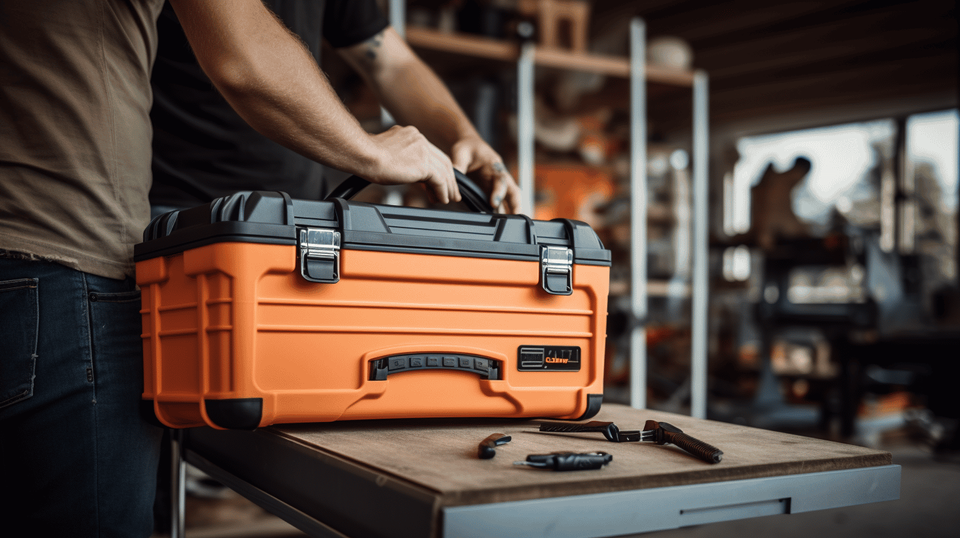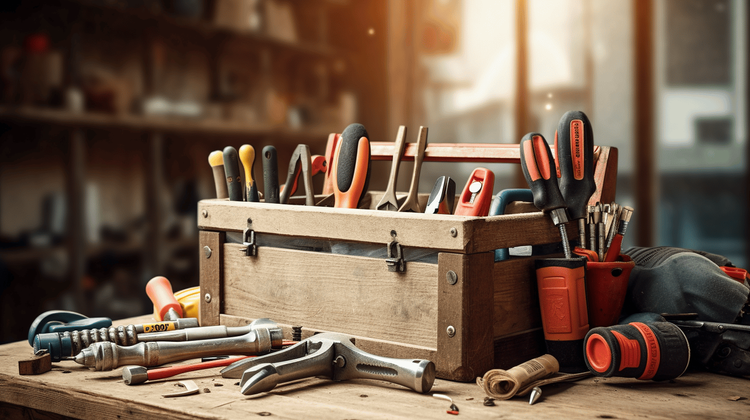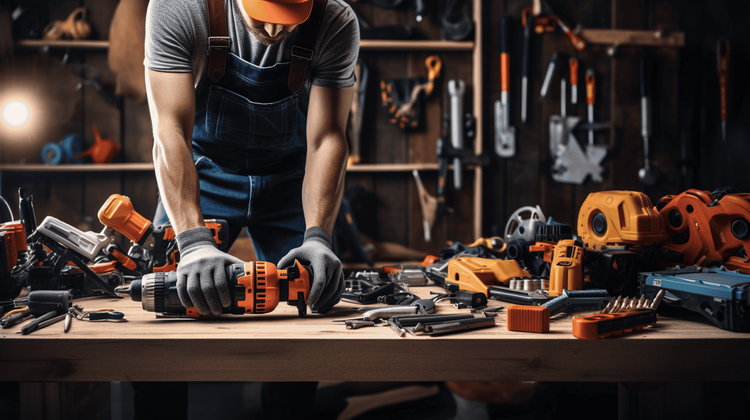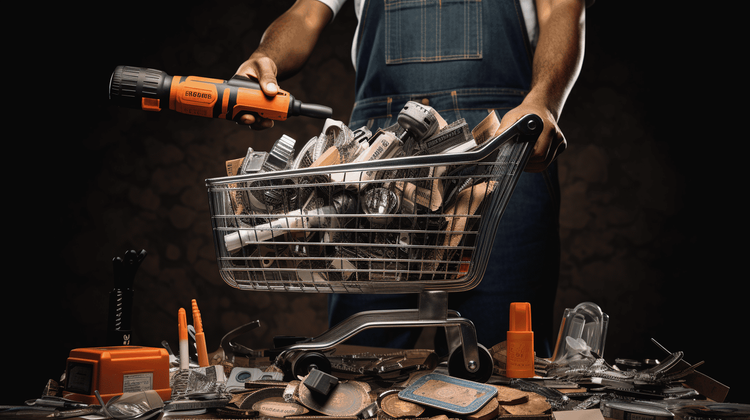Money-Saving Mastery: The Savvy DIYer's Guide to Amazon Tools

The DIY lifestyle comes with a sense of achievement, creativity, and above all, economic savings. Imagine transforming your living space with your own hands or fixing that pesky leaky faucet that's been bothering you for months. Picture the thrill of developing new skills, the fun of embarking on projects, and the satisfaction of seeing the results.
This guide is specially curated for the emerging DIY enthusiast who is ready to dive into the world of self-made magic, providing insightful details on the amazing range of tools on Amazon. You'd wonder how you ever managed without a screwdriver or a power drill in your life!
As we lead you through the labyrinth of tools and materials, we'll also share expert tips on maximizing your Amazon shopping experience, selecting the right tools, making smart purchases and maintaining your tools. All to ensure that your DIY journey is not just about getting your hands dirty, but also about nurturing a sustainable hobby and making the most of each dollar spent.
Let's dive right in! After all, every home is a project waiting to happen. 😊
Taking a Step Towards DIY: Where to Begin
Are you tired of waiting for a professional to fix simple things around your house? Do you often gaze at beautifully handcrafted furniture pieces and wish you could create something on your own? If you've nodded-off to these, then it's time to take a giant leap into the wonderful world of DIY projects! Don't let apprehension hold you back. Here's a simple guide to help you embark on the journey towards acquiring a brand new skillset that not only brings a sense of accomplishment but also saves money.
Defining Your DIY Goals
Before you jump into the DIY vortex, you first need to clearly define your goals. Setting clear, realistic objectives will ensure your DIY efforts are focussed and rewarding. Here's how to get started:
- Identify Why You Want to Do DIY: Is it to save money, gain a new skill, or keep yourself occupied? These questions will help you determine which type of projects you should pursue.
- Consider Your Interest and Skills: Each DIY project requires a specific set of tools and skills. If you're tech-savvy, you might want to venture into home automation. A passion for painting might push you towards revamping your home's interiors. Understanding your inclinations will help steer your DIY journey in the right direction.
- Set Achievable Goals: As a rookie, don't bite off more than you can chew. Start with a small, manageable task. This helps avoid unnecessary stress and keeps the learning process enjoyable.
Planning Your Projects
Once you've defined your DIY goals, the next step is to plan your projects. Giving proper thought to the project before starting prevents unnecessary wastes of time, money, and effort.
- Research Your Project: Use trusted resources to gather detailed instructions, and familiarize yourself with the necessary steps. This reduces risks and ensures the project's smooth execution.
- Prepare Your Equipment: Make sure you have all the required tools before embarking on your project. This prevents frustrating stops and starts while you're in the middle of the work.
- Plan for Safety: It's easy to overlook safety when you're caught up in the excitement of a new project. Always wear protective gear, and make sure you're aware of the potential hazards associated with the tools and materials you are using.
Remember, DIY is about cultivating a can-do attitude and having fun while you're at it. Mistakes will happen, but they're all part of the learning process. The crux of the matter is that DIY is not just about being handy - it's about the joy of creating something with your own hands. It's the smiles that light up when you stand back and say, "I made that!" So, why wait? Let's embrace the DIY spirit. Embark on this exciting journey and let your creativity take flight. 🚀
Selecting the Right Tools for Your DIY Projects
Taking on a DIY project can be tremendously rewarding. Not only do you create something unique with your own hands but also gain a wealth of knowledge in the process. You can feel the rush of creativity flowing through you as you map out your plans, imagine the end product, and roll up your sleeves to get started. However, as exciting as DIY projects can be, you need to understand that the tools play a crucial role in your project’s success. So, how do you choose the right essentials?
Understanding Your Needs: Basic to Advanced
Regardless of whether you are a DIY newbie embracing the excitement of creating something for the first time, or a seasoned DIY veteran exploring exhilarating new project ideas, you need tools that match your skill level.
- Basic Tools: If you fall into the category of beginner DIY enthusiasts, you might only need basic tools. This could include a hammer, screwdriver, pliers, and a wrench. Independent of the project, these tools are essential and provide a good foundation as you delve deeper into the DIY world.
- Advanced Tools: For the DIY veterans, their toolkit might look a little more complex. It could include power tools like drills, circular saws, or even more specific tools like soldering irons or air compressors. The objective is to select tools that can handle heavy-duty projects and facilitate intricate designs.
Criteria for Choosing the Right Tools
Identifying the correct tools is more than just recognizing the increase in complexity that comes with experience. There are several other factors you need to consider to ensure you're making a conscientious choice. Let's break it down:
- Performance and Durability: Always look for tools that are known for their performance and durability. They should be able to withstand repeated use while maintaining their functionality.
- User-Friendly: No matter how great the tool is, if you can't figure out how to use it in under five minutes, it may not be the right one for you. Look for models with simple instructions and straightforward design.
- Safety Features: DIY projects are fun but safety should be your top concern. Therefore, your tools should have thorough safety instructions and features like automatic shut-off or safety locks.
To round things off, remember, the most important thing about DIY projects is enjoying the process. With the right tools and knowledge, your journey should be as gratifying as the end product.
Making the Most of Amazon for DIY Tools
Be it a hobbyist carpenter crafting a bespoke piece of furniture, or a dedicated DIY enthusiast fixing things around the home; everyone needs the right tools for the job. Amazon, with its vast selection and competitive prices, has become the go-to online platform for most tool seekers. From power drills to paintbrush sets, Amazon's vast e-commerce network caters to a broad range of needs and wants, making it a popular choice for all things DIY.
Benefits of Buying from Amazon
Amazon is more than just an online marketplace. It's a cornucopia of products where choices are endless and delivery is precise and quick. Let's shed some light on why Amazon can be your best bet for sourcing DIY tools:
- Wide Range: Amazon's online catalogue is second to none, boasting a diverse range of tools suitable for any DIY project. Whether you're looking for a simple screwdriver or a complex power tool, Amazon is your one-stop-shop.
- Competitive Pricing: With numerous vendors competing for your attention, you're likely to find some of the most competitive prices on the market. This competition often means more savings for you.
- User reviews and ratings: Amazon's user review and ratings system allows you to make informed buying decisions by reading about others' experiences.
- Ease of Delivery: With its reliable delivery network, Amazon ensures your tools reach you in a timely and hassle-free manner. Plus, Prime members can enjoy free and fast shipping on eligible items!
Finding Deals and Discounts
Being savvy when shopping on Amazon can land you some excellent deals. Flash sales, seasonal offers, and markdowns are common occurrences, but they often require a bit of digging. Consider subscribing to Amazon's deal notifications to stay in the loop. You can also make use of price comparison tools available on the platform to ensure you're getting the most bang for your buck.
Choosing Reputable Vendors
Not all vendors on Amazon are created equal. Establishing trust with your chosen vendor is crucial when shopping online. Always prioritize sellers with high ratings and positive customer reviews. Go through the product descriptions meticulously and ensure your chosen product is covered under Amazon's A-to-z Guarantee.
Amazon is not just a marketplace; it's a community. The more informed and involved you become, the better your shopping experience will be. So, next time you're starting a DIY project, remember - Amazon is just a click away, ready to cater to all your tool needs.
Learning Before Purchase: Online Research & Free Resources
In our digital era, online shopping has become the order of the day. However, nothing can ruin your day faster than purchasing a product only to realize it does not meet your expectations. Thankfully, the vast sea of the internet provides an exceptional platform not just for buying, but for in-depth research too. In this section, we explore a few methods and resources to help you learn about a product before making a purchase, ensuring you get maximum value for your hard-earned money.
Maximizing Use of Item Descriptions and Details
One of the first things you should do when considering an online purchase 🛍️ is to read the product description and specifications. Unfortunately, most of us simply glance through these details, scrolling down quickly to check the reviews.
However, product descriptions:
- Offer critical details about the product, such as material, size, or voltage.
- Provide care and maintenance instructions, something you'd wish to know before buying.
- Can give an insight into the product’s warranty.
Simply put, a product description is the first comprehensive guide to what you're buying. It's like a mini handbook 📖 that outlines the product's most important features and specifications.
Leveraging Amazon’s Q&A Section
Amazon, being the largest online marketplace, offers a unique feature: the Questions & Answers (Q&A) section. This section allows potential buyers to place inquiries about the product and get responses either from previous buyers or the seller.
Some valuable insights the Q&A section provides include:
- Addressing product-specific concerns and queries.
- Sharing real-life experiences of using the product.
- Highlighting any product defects or instructions that weren't clearly stated in the product description.
Next time you're on Amazon, ensure to examine the Q&A section. You'll be surprised at the wealth of info waiting there for you!
Exploring Online DIY Communities for Tips
You wouldn't believe how resourceful the online Do-It-Yourself (DIY) community can be! Platforms like Quora, Pinterest, and even YouTube have tons of DIY enthusiasts sharing tips, hacks, and tricks related to various products.
For example:
- Quora and Reddit threads often involve detailed discussions about specific product functionalities.
- YouTube reviews offer visual demonstrations on how a product functions.
- Pinterest provides creative ways to use the products differently.
These communities help you understand not just your desired product, but also alternative ways to use it, thus saving you money and promoting creativity. Now, who wouldn't want that? 🚀
In all, taking time to research and learn about a product before purchase online can lead to a more informed and satisfying shopping experience. So, next time you're about to click on that 'Buy Now' button, remember to spend a few moments diving into the product descriptions, Amazon’s Q&A section, and various DIY online communities. It’s all about embracing Learning Before Purchase, and your wallet will thank you!
Preventing Buyer's Remorse: Strategies for Smart Purchasing
No one knows the sinking feeling better than someone who's just made a purchase, only to realize later that their new buy doesn't meet their needs. Heck, sometimes the regret hits before you've even left the store! To save you from this emotional rollercoaster, we've put together some smart strategies to prevent buyer's remorse. Following these tips can help you make smart decisions, whether for your everyday purchases or for those larger long-term investments.
Sticking to Your Budget
Ah, budgeting - the ultimate buzzkill. However, one foolproof way to avoid buyer's remorse is by adhering strictly to your budget. Here's why:
- It keeps your spending in check, ensuring you only fork out the cash when you can afford to.
- It prevents regretful purchases, as you're less likely to succumb to deals and discounts on items you don't need.
- It promotes conscious consumption, meaning you're more thoughtful about your purchases.
We know, living by your budget isn't always glamorous. But trust us; the stability it provides is unmatched. This method guarantees you'll be happier with your pocket and your purchases.
Avoiding Impulse Purchases
Ever found yourself standing at the checkout, wondering how you ended up with a cart full of items you didn't plan to buy? Welcome, you've fallen prey to impulse shopping. Let's see how we can avoid it:
- Shop with a list and stick to it. Whether it's groceries, clothes, or home decor, commit to buying only what's on the list.
- Give yourself a 'cool-off' period. If something catches your eye that wasn't on the list, go home and think about it. If you still want it after 24 hours, consider it may be a genuine need.
- Stay clear of sales and limited time offers. These tend to create urgency, leading you to make hasty and often regretful decisions.
Taking control of your shopping habits takes a bit of discipline, but the benefits are outstanding. You'll find yourself making fewer regretful purchases, saving money, and leading a less cluttered lifestyle.
Making Informed Decisions
Another way to mitigate buyer's remorse is through making informed decisions. It's simple once you get the hang of it:
- Do your homework. Research products before making a purchase. This could be reading reviews, watching tutorials, or gathering insights from friends and family.
- Evaluate your needs. Ask yourself why you need the product, how often you'll use it, and whether it fits into your lifestyle.
- Look for quality, not quantity. It's better to invest in one well-made, durable item rather than buying multiple cheaper ones that'll wear out sooner.
You see, by making informed decisions, you invest in products you genuinely need or want. And post-purchase remorse becomes a thing of the past.
Preventing buyer's remorse is less about denying yourself and more about becoming a responsible and conscious consumer. So the next time you're about to make a purchase, remember these golden rules. You'll thank yourself later! 😉
Maximize Tool Lifespan: Care and Maintenance Tips
If you're a handyman or a DIY enthusiast, your tools are likely among your most prized possessions. They're the backbone for bringing all your creative, fix-it, and improvement projects to life.💪 But for them to serve you effectively and for a long time, you’ve got to give them some tender loving care. Here's how you can maximize the lifespan of your tools through proper care and maintenance.
Cleaning and Protecting Your Tools
You must never underestimate the power of cleaning your tools after every use. Rust and residue can quickly deteriorate the performance and longevity of your tools. Here's a few key steps to doing it right:
- Wipe down your tools with a clean dry cloth
- For stubborn dirt or stains, use a mild detergent or a brush
- Dry the tools thoroughly to prevent rust
- Protect your tools by applying a thin layer of a protective product, like WD-40 or machine oil. This also helps to keep rust at bay.
And remember, never put away tools that are still dirty or damp, as this can lead to rusting and corrosion over time.🚫
Proper Tool Storage
When it comes to tool maintenance, where and how you store them is as important as how you clean them. Proper storage not only guarantees the longevity of your tools but also ensures they’re always ready for your next project. 📦
So, where should you keep them?
- Keep your tools in a cool, dry place
- Make sure they are easily accessible
- Invest in a good toolbox or shelving system, this can make a huge difference
If you have power tools, remember to remove the batteries before storage to prevent damage.
Routine Maintenance
Consistent check-ups can work wonders in prolonging the life of your tools. So, it’s a good idea to schedule routine maintenance. The checks you perform can vary, but here are some basics:
- Sharpen blades regularly
- Check the chords or extension wires for power tools
- Verify that handles and other parts are secure
Remember, good tool maintenance requires consistency.🔧
So, there you have it! Follow these care and maintenance tips and your tools will thank you by standing the test of time. Remember, clean regularly, store properly, and don't forget those routine checks. Do right by your tools and they'll do right by you. Happy DIY-ing, folks! 🛠️
Conclusion
Embarking on the journey of DIY can be as exciting as it is rewarding. With a clear set of goals, the right tools in your arsenal, and a smart approach to budgets, the world of DIY becomes a landscape where you can freely build your dreams. Embrace the art of learning from online resources, like Amazon's Q&A section, or seek advice from online DIY communities. And while purchases can indeed fuel your projects, it’s the informed decisions that ensure the best value.
Now, when it comes to the lifespan of your tools, clean, protect, and carry out routine maintenance and ensure to store them properly. Consider a handy storage solution like the Bit Holder Keychain from Ultra Handy - a lifesaver for professionals and DIY enthusiasts alike. Its keychain design makes organizing and locating screwdriver bits an effortless task.
By following these handy tips and insights, DIY empowerment is well within your grasp. So, here’s to saving money, gaining skills, and finding joy in the projects you create.
Frequently Asked Questions
- What are the essential money-saving tools on Amazon?Some essential money-saving tools on Amazon include price comparison extensions, coupon websites, cashback apps, deal aggregators, and browser extensions that notify you of price drops and discounts.
- How can I find the best deals and discounts on Amazon tools?To find the best deals and discounts on Amazon tools, you can: 1. Subscribe to Amazon's newsletters and follow their social media accounts, 2. Use deal aggregator websites to find the latest discounts and offers, 3. Use price comparison tools to compare prices from different sellers and choose the best deal.
- Are there any free tools on Amazon for money-saving?Yes, there are free tools on Amazon that can help you save money. For example, Amazon Assistant is a browser extension that notifies you of deals, compares prices, and offers cashback rewards.
- Can I use Amazon gift cards to save money on tools?Yes, you can use Amazon gift cards to save money on tools. You can buy discounted gift cards from various online platforms or earn them through reward programs. Applying gift cards during checkout allows you to reduce the total cost of your tools.
- Is it safe to buy tools from third-party sellers on Amazon?While there are reputable third-party sellers on Amazon, it is important to do your research and read reviews before purchasing from them. Check seller ratings, customer feedback, and return policies to ensure a safe and satisfactory buying experience.




